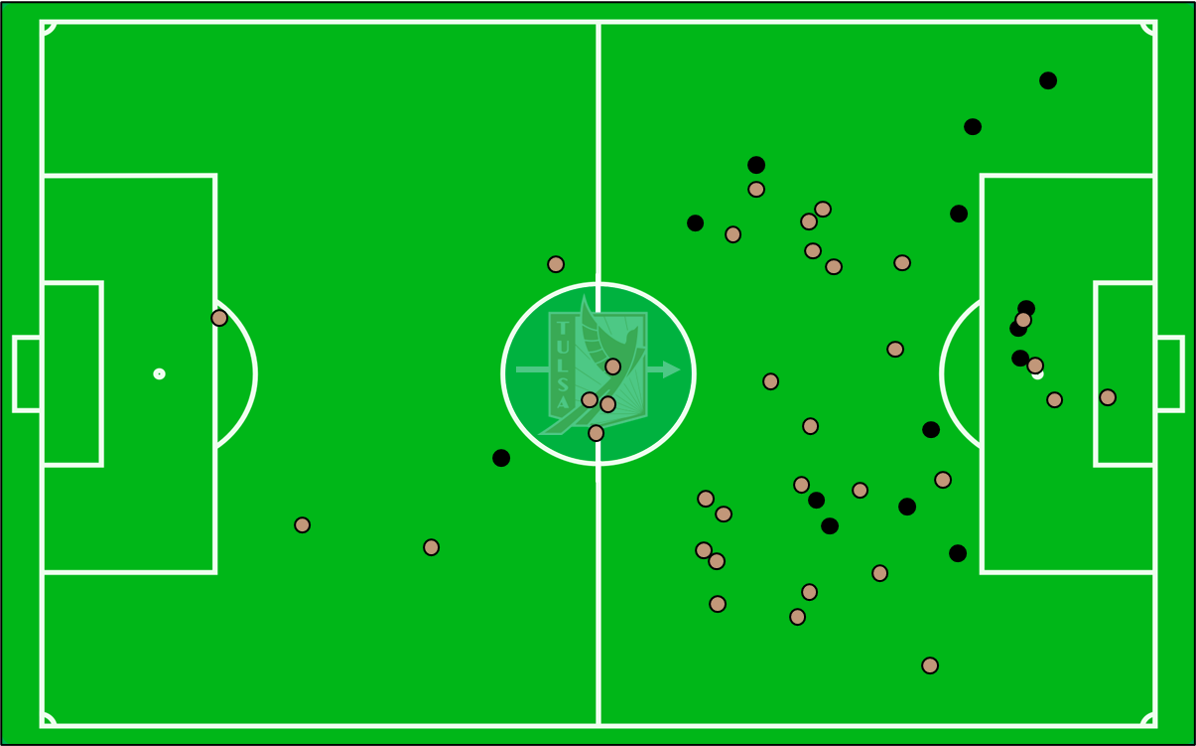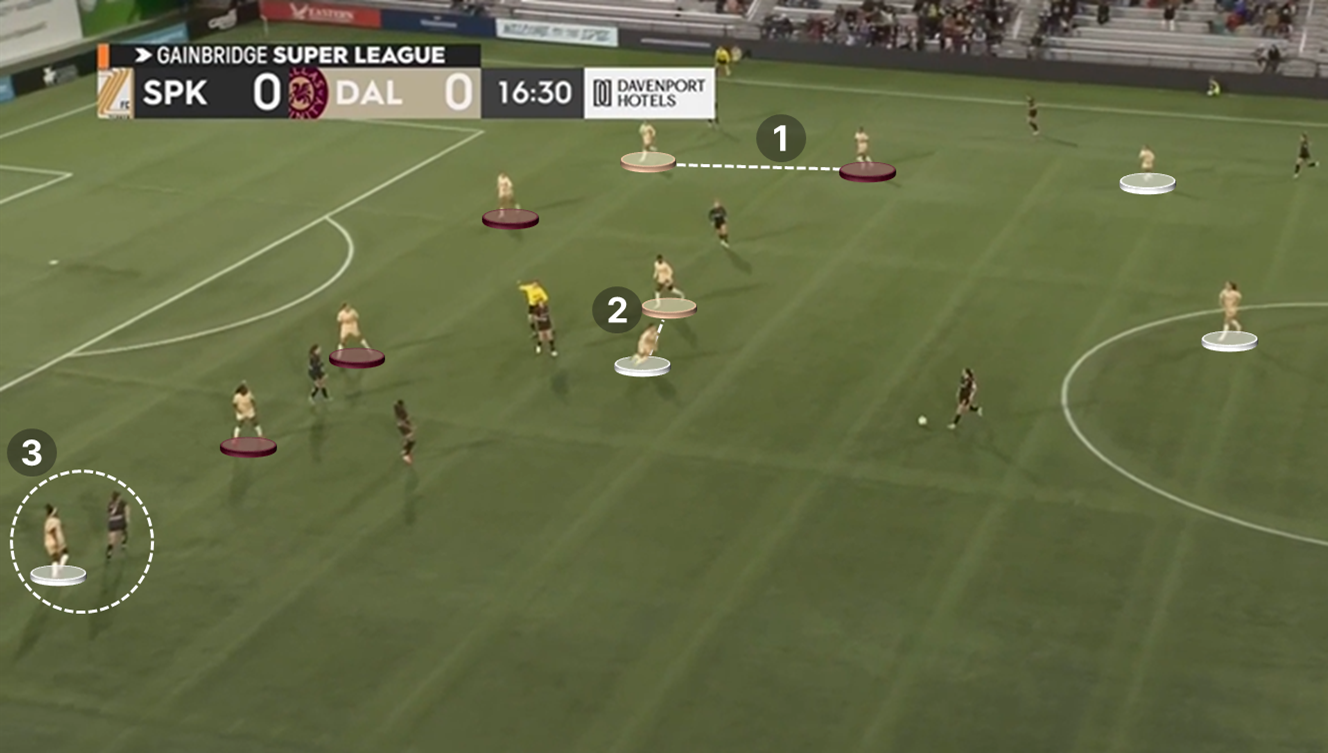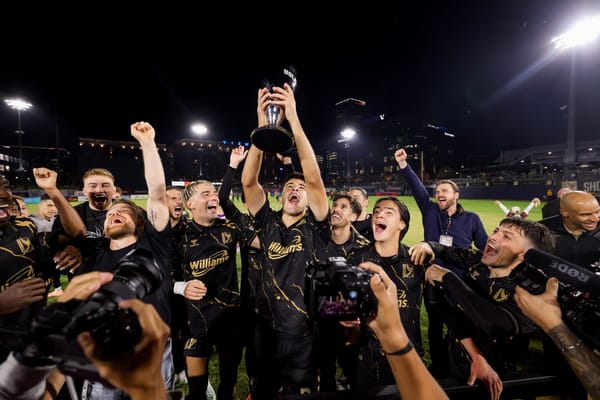The Back Four: Post-title takeaways
On Perrin Barnes, Stefan Lukic, and two Super League standouts

Welcome in to The Back Four!
As always, visit Backheeled for more USL content, including deep-dives into the title game and a broad offseason preview. Also, check out This League! for an audiovisual dive into the week that was.
Without further ado, let’s get to it.
Perrin Barnes and Pittsburgh's defense
Back at the end of June, I watched the Pittsburgh Riverhounds go to Portland and fight to penalty kicks against Hearts of Pine. My takeaway then? Charles Ahl is really good.
Fast forward six months, and I'm at a similar place after seeing Pittsburgh win a title against FC Tulsa: when it mattered the most, Perrin Barnes was one of the best players on the field. In every way, it's a testament to how the Riverhounds built a team worthy of a championship.
Ahl is a classic Pittsburgh player, a rookie out of Stetson that gradually earned his way into the lineup. We've seen a number of players follow that arc, but Barnes is something different. As a rookie with MLS Next Pro's Huntsville in 2023, the former Butler star started only two matches and garnered 440 minutes. He didn't even play pro ball in 2024, yet the Riverhounds knew something was there. That vision was rewarded last weekend.
In the final, Barnes’ defensive contributions stood out. The right wingback picked up six tackles and seven clearances, going 12/18 in duels. If it was Barnes’ attacking movement that stood out in the Eastern Conference Final – his run into the box set up the game-winning goal – we got the completeness of his skillset in the title game.
Here, Tulsa is starting to break in the wake of a Pittsburgh set piece. Barnes and fellow wingback Junior Etou – neither anything like an aerial threat – are positioned low in case of a counter, and you can see them turning on the jets to try and stop Kalil ElMedkhar and Taylor Calheira's momentum.
ElMedkhar cuts in to potentially freeze the defense, releasing a through to Calheira after stepping inside. Still, Barnes isn’t fooled. He stays tight to the all-USL forward, harrying him at every touch and shepherding him toward the sideline. Calheira might be the league’s best one-on-one dueler, but Barnes never lets him get free and puts in a sliding tackle before anything can come about in the box.
It’s a clean zone exit from there, emblematic of the way Pittsburgh smoothly skirted the counterpress for the most part. Still, it’s Barnes’ half-field recovery that’s especially key.
Here, you’re seeing the rare Pittsburgh giveaway, but disaster is once again averted by #3. I noted in my Backheeled column that Eric Dick hit every single one of his passes long in this match, meaning that the ‘Hounds didn’t spend much time in this intermediate phase. Much of the game was played in the respective attacking thirds, and midfield action tended to be stop-start.
In this case, that isn’t true. Tulsa is able to fully engage the No. 8s within their 3-4-3 press, and it’s ultimately a charge from Giordano Colli that rushes Pittsburgh into a turnover.
When that pass is developing, you can see Barnes starting to cheat upfield in anticipation of entrance into the attacking zone. Still, he’s wise to the fact that the ball ends up at ElMedkhar’s feet, immediately turning tail to recover toward the box. From there, Barnes sprints to ElMedkhar’s inside and knocks the ball loose as the winger tries to find his right foot.
This might not seem like an especially key sequence, but Tulsa anchored their 2025 success around similar turnover-and-break moves. Stopping these sorts of breaks was critical to the Pittsburgh formula, and Barnes made it happen. Ultimately, those spirited rotations and a genuinely all-time goalkeeping performance from Dick to scrape through to penalties.
Barnes didn’t start a match until mid-April and missed much of the early fall because of an injury. He didn’t start Pittsburgh’s first playoff game against Hartford, and he may not’ve re-entered the lineup had Guillaume Vacter not been injured. Still, when push came to shove, the 24-year-old was the man of the moment. You couldn’t pick a better embodiment of this club: largely overlooked outside of Pittsburgh, Barnes brings a mix of discipline and ceaseless effort that explains why the Riverhounds are your 2025 champions.
(Aside: with eight catches and 22 recoveries, Dick set new season-highs in both categories. Not personal season-highs, either; literally the most of any player in a single game across the 2025 season.)
Requiem for Stefan Lukic
Stefan Lukic made his name because of late-game heroics throughout 2025, scoring eight substitute goals across all competitions. He nearly pulled off the same thing in the title game. It’s easy to focus on Lukic’s decisive shootout miss, but his presence changed the game for FC Tulsa and would've produced a winner against a lesser defense.
This year, Lukic led all attackers in shots per 90 minutes (4.5) and ranked in the 98th percentile for box touches (5.8) by the same parameter. The Serbian international is terrific when he’s close to goal, with a bloodhound’s nose for the ball in chaotic, post-set piece scrambles. We saw some of that against Pittsburgh, but it was Lukic’s hold-up play that truly changed the look of the match.
Here, you’re seeing Lukic’s touches (in gold) and Taylor Calheira’s (in black) from the 70th minute onward…

…and it should immediately pop just how many involved Lukic was compared to an all-league striker. Now, that obviously owes to Lukic’s wing role. Still, he managed to take more box touches than Calheira in their shared 50 minutes on top of the midfield involvement.
Tulsa ran a typical 3-4-3 against the Riverhounds, but they added layers as the match went on. Other substitutes like Owen Damm and AB Cissoko allowed Tulsa to retain that base shape while occasionally hedging into a 3-5-2ish mode, particularly in transition breakout situations.
To get there, one winger would drop low to hold play up while the other operated like a second No. 9. That could be Lukic dropping low – remember that touch map! – or Jamie Webber doing the same thing, thus allowing the super sub to maximize his impact upfield.
Here, you’re seeing a typical Tulsa short-field move. Initially, all-league defender Lamar Batista is able to out-muscle Augi Williams – something he did regularly while going a jaw-dropping 17/24 in duels. Batista's takeaway allows the ball to find Webber in the pocket amidst the Pittsburgh pivot, and it's off to the races.
The South African's presence forces defensive midfielder Jackson Walti to commit, opening a lane to squeak a pass into a low-seated Lukic. By then, the 3-2-5 shape is clearly developing: both Damm and Harvey St Clair are pushing up from wingback to stretch Pittsburgh out, whilst Calheira is probing across the back line to try and stop the center backs from stepping up.
Lukic is able to receive in space, and while his pass toward St Clair's overlap isn't especially clean, it gets the job done. The right wingback can tee up a cross, and you can see Lukic curling his run around Calheira as the serve comes in. Pittsburgh can't clear the ball away cleanly, allowing the super sub to get a look and nearly beat Eric Dick for the game-winner.
Nearly, of course, is the operative phrase. Lukic spearheaded something like a half-dozen of these sequences (which were really a testament to Tulsa's back-to-front connectivity more than one single player!) yet couldn't galvanize that all-important goal.
Sometimes, that’s just how the game plays out. FC Tulsa finished with a 1.85 to 0.80 xG edge and often felt like the better side, particularly with Lukic in. In the immediate aftermath of a tough loss, it’s easy to lose perspective, but this year was a triumph at ONEOK Field. Tulsa has never been better, and they’re extremely well-positioned to compete in 2026. With Luke Spencer and Caleb Sewell running the show and continuing to identify talents like Lukic, it wouldn’t be a surprise to see this club get a second bite at the apple in the near future.
Sporting Jax's attack
Now up to second place in the USL Super League, Sporting Jax is doing a lot of things right. They’re second in the division with a +0.23 xG margin per game, and they rank in the top three – alongside Carolina and Lexington – in terms of field tilt (53%) and final-third recoveries (6.3) per match.
If those numbers make anything clear, it’s that Jacksonville is playing incredibly positive soccer, much less by the standard of an expansion side. Stacey Balaam’s wonderfully bright 3-5-2 has all the tactical complexity you’d expect from a veteran unit. It’s all the more remarkable given that much of Jacksonville’s roster is composed of numerous first-year players.
This team tends to press in a 3-1-4-2, with the paired strikers matching opposing defenders man-to-man. Against back threes or especially clever short-build units, star No. 8 Ashlyn Puerta may pop up out of the midfield. No matter, you'll see two reactions when the ball swings toward the wings: aggressive closure by way of the wingbacks, and midfield rotation that’s meant to trap at the sideline.

Jacksonville’s mids typically align in a triangle with two high No. 8s and a low No. 6. Passes toward the sideline trigger traps, with two midfielders (the ball-side No. 8 and deeper No. 6) running toward the receiver with additional support arriving from the wingback spot.
Above, though, you're seeing variation from Saturday’s match against Fort Lauderdale. While United is a 4-2-3-1 side on paper, they like to drop Madison McComasky from the No. 6 spot into the center of a functional back three with the ball. That’s what’s happening here, so Puerta (in yellow) steps to cover the on-ball center back whilst striker Baylee DeSmit (white) addresses the low-seated mid.
You see McComasky X-marked at the right edge of the frame, but Jacksonville also bends their shape to limit United’s No. 10 further upfield. Because Puerta has stepped, there’s potentially space in that channel, but center back Grace Phillpotts (blue) pushes high to mark Stella Nyamekye and plug that hole. Even if a pass comes through, Sophie Jones is ready to intervene from the No. 6 spot; she had six recoveries and a tackle last weekend.
None of these things are atypical in the modern USL, of course. What differentiates Jacksonville is how effective their defensive rotations have been from the jump – and how they’ve liberated players like Phillpotts and wingback Meg Hughes to turn that elevated positioning into an attacking tool up the left side.
What does that look like in practice?
Here, Balaam’s side has just lost the ball in the offensive zone, but they aren’t allowing a slick Fort Lauderdale transition attack to engage. From the jump, Hughes is applying backpressure to the United carrier, forcing a somewhat rushed pass. When it connects, Jacksonville’s Georgia Brown – the centermost center back – is there to force a quick turnover.
At that point, Phillpotts (in blue) gets on the ball and creates a passing triangle alongside Puerta (in yellow) and Hughes. Most of the opposing defense is drawn toward the former pair, so Hughes can receive in a one-on-one; meanwhile, Phillpotts follows up her pass with a terrific run that takes out much of the back four.
Because of Puerta’s gravity and Phillpotts’ pass-and-move brightness, United can’t maintain their spacing. As a result, Hughes has room to hit striker Paige Kenton in the box.
The fact that a center back and wingback are stirring the drink to this extent is remarkable, and it’s at the heart of Jacksonville’s system. 12.5% of Phillpotts’ passes come in the final third, by far the most of any Super League center back; Hughes added 30 attacking-half passes and four chance creations of her own last Saturday.
There’s a sense of balance amidst it all, mainly due to Carolina Murray’s nous at right wingback. Murray is one of just two players on the team over the age of 30, having spent the better part of a decade in Northern Europe. At times, Jacksonville almost looks like a back four team with Murray steadfastly sitting low while Hughes and Phillpotts do their thing; still, the Wisconsin native ranks in the 83rd percentile for cross attempts and knows when to get forward.
Jacksonville tends to be an intermediate passing team, mixing in long restarts with shorter attempts in settled possession. Their average pass is among the shortest in the Super League, traveling just 6.8 vertical yards per attempt, yet they‘ve posted the second-highest share of launched goal kicks (more than 40%) in the division.
Here, Sporting is resetting in possession after a long ball, with the ball initially at Brown’s feet. As Fort Lauderdale pushes ahead to press in this semi-transitional moment, Puerta gets a touch and goes to work through the middle.
Puerta has been unbelievable in her 18-year-old season; she’s got 12 goal contributions already, adding 4.9 recoveries and 1.8 successful dribbles per game on top of that. Her central gravity does wonders to open up halfspace overloads, and you’re seeing why as she splits two defenders and carries into the final third above.
There, both forwards are making runs to test the back line, whilst Murray and Hughes are also getting upfield. Jacksonville can’t strike before Fort Lauderdale clogs the box, but Puerta‘s ingenuity at the start of the play and ability to find a shot are stellar.
When Jacksonville finally got on the board in the 33rd minute, it was Puerta’s off-ball movement that stretched United and freed a pass over the top into Kenton – a tidy example of the USYNT star’s gravity and this club’s vertical upside. At their best, Jacksonville are wonderfully dynamic and varied, and they proved it again over the weekend.
We saw plenty of clubs fade after a hot start in the 2024-2025 campaign, but Jacksonville – knock on wood – feels more sustainable. The numbers don’t lie: Sporting Jax is a legitimate top-three team because of their field-dominating identity, not because of fluky finishing. Balaam has been extremely clever in building out this system, and we’re continuing to see it flourish as the weeks roll by.
Trinity, tightening up
I've been somewhat negative about Dallas this season, so I wanted to carve out a brief space to highlight their victory against Spokane a week back. That 2-0 away win was less of an offensive showcase than we became accustomed to a year ago, but it featured the growth that we've been waiting for in the 2025-2026 campaign.
Dallas has allowed 9.5 passes per defensive action this year, third-highest in the Super League. Last year, their mark of 7.2 was the division’s lowest – evidence of a completely reinvented approach that’s far less interested in intense pressure. It’s taken time to find an equilibrium under the new system, but the clean-sheet win in Washington evidenced how Dallas has sharpened up.
Manager Chris Petrucelli set up in a 4-2-3-1, but that shape was liable to bend to stop Spokane’s preferred patterns. Chioma Ubogagu tended to drop low on the right wing to shadow aggressive left back Kelsey Oyler; left-sided Camryn Lancaster stayed much higher to address narrow fullback Haley Thomas and weaponize her own breakaway threat in transition.
Dallas wasn’t always in control. They ceded a 58% field tilt, and their offense was primarily composed of “hit it long, press the incompletion, and see if Lancaster and Allie Thornton can find a gap” coin-flips. They didn’t take a shot until the 29th minute, but that was Trinity’s best-case scenario: the initial long ball was claimed at halfway, leading to a slick side-to-side passing play and a headed goal for Sealey Strawn.
That said, the defensive was the highlight, and I want to focus on one explanatory frame that illuminates Petrucelli’s low-block machinations.

Right off the bat, I’ll concede that this looks messy. It’s more of a 6-2-2 than anything else, but that’s a function of me cherry-picking a particularly evocative moment. Across the board, this is actually a great example of the 4-2-3-1’s defensive integrity – that intense rotation is frustrating Zephyr! – but what stands out?
Wide coverage (#1): You’ll first notice that midfielder Gracie Brian, marked in gold as part of the pivot, has rotated toward the left side (i.e., top of the frame) and is filling the left back spot.
Generally, Dallas used their fullbacks to aggressively address Spokane’s wide players throughout this match. That's why rotation is necessary here: left back Cyera Hintzen – who led the team with three interceptions against Spokane – has stepped up against a Thomas reception, and Brian has filled behind her.
That’s the trade-off. If you want your fullbacks to close down upfield, someone needs to cover behind them. Here, Brian does so splendidly, and that was par for the course.
Pivot stability (#2): Still, that rotation introduces another quandary: who’s filling for Brian in the 4-2-3-1’s pivot? In this case, it’s Strawn (marked in white as an attacking player) filling next to Wayny Balata up the middle.
Balata and Brian played with a real sense of space-clogging responsibility, preventing the quick between-the-lines penetration that’s plagued Dallas at their feeblest. The pair didn’t win a single tackle in Spokane, but their central presence limited Zephyr to merely three completions from zone 14 into the box.
Even when one of the two had to cover a different area, Strawn was ready to chip in. Often used in wider spaces during her Young Player of the Year-winning rookie season, the US U-20 starlet has looked equally comfortable in a different role late in 2025.
Right-side depth (#3): As mentioned, Dallas tended to tilt Ubogagu lower on their right side to deny combination play between Oyler and Ginger Fontenot up the Spokane flank. Ubogagu was often responsible for directly marking Oyler in the defensive third, in fact, and that’s what you’re seeing here: the Dallas winger functionally is a fifth member of the back line as she tracks the Zephyr overlapper.
While Oyler led Zephyr with four shots within the box, those chances never came easy. That was true of the entire performance. Spokane finished with 1.99 xG, but 0.8 of it came in a single scramble in the third minute that was ably handled by goalkeeper Rylee Foster. Indeed, Foster was holistically excellent in terms of her cross coverage and in-box control.
Should Dallas be concerned by the high xG total? To an extent, but finishing against a crowded low-block defense is hard! Spokane only put 0.86 xG on target, which is far more indicative of the way Trinity shut them down. That'll be music to the ears of Petrucelli, whose side enters the Thanksgiving break feeling like they've made a significant stride.
Quick Hits
In other news this week…
- Thanks to everyone at FC Tulsa and everyone who I got to meet in person over the weekend for a tremendous time. The USL community is what makes all this work worthwhile, and I couldn't have felt it more strongly in Tulsa.
- Another “thank you” to everyone who reads my work at Backheeled and on this blog. It’s a colossally dumb amount of labor, but I’m (hopefully) filling a niche for the people who care about the USL and the sport of soccer in America more generally. The fact that anyone consumes this stuff is mind-blowing, and I greatly appreciate it!
- Related: go check out the United Soccer Lounge post-game interview with Eric Dick from Saturday.
- Related again: read Nicholas Murray on Eric Dick.
- Great piece from RootsBlog on the sporting structure in Oakland. Do what you will with the hierarchy or lack thereof, but the Ryan Martin hire is an undeniable slam dunk for the Roots – he's the kind of identity-setting manager that instantly improves any club, regardless of their org chart.
- Sebastian Guenzatti heading back to the New York Cosmos is my love language.
Cover Photo Credit: Pittsburgh Riverhounds / Twitter




